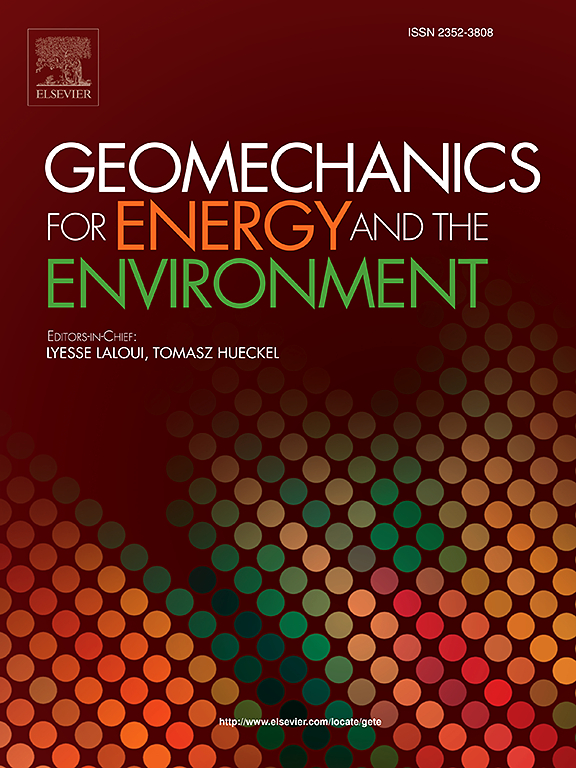考虑热力学行为的基于机器学习的能量桩热力学参数反演
IF 3.7
2区 工程技术
Q3 ENERGY & FUELS
引用次数: 0
摘要
根据设计规范进行能源桩岩土工程勘察时,岩土热力学特性是必不可少的。地层和桩的热参数一般通过热响应试验(TRT)确定,力学参数一般通过抽样或现场测试获得,部分参数也根据工程经验确定。然而,一方面,TRT和原位测试是一个耗时近一周的昂贵和劳动密集型过程。另一方面,不能保证个人经验对参数确定的准确性。参数反演调整数值模拟值(最初来自测试/经验),以补偿采样效应、地层变化和造成模拟误差的人为偏差。基于机器学习的代理模型近年来越来越受欢迎,是一种很有前途的反演加速解决方案。通过对预先计算的数值模拟结果进行训练,代理模型可以以更快的速度模拟系统的行为,同时与传统的数值模拟相比,减少了计算时间和财务成本。本研究提出了一种基于机器学习的代理模型参数反演的新方法。首先通过模拟能量桩的小尺度物理试验,建立了能量桩的数值模型。随后利用拉丁超立方体采样为XGBoost模型开发生成足够的数据,随后进行敏感性分析以进行参数筛选。然后用非支配排序遗传算法实现参数反演。通过4个实际测试条件验证了该方法的有效性。结果表明,该模型具有较高的拟合精度,温度和轴向力的R2分别在0.97和0.9以上。最后,参数反演结果表明,所提出的反演方法具有良好的应用前景,能在一定程度上揭示材料的综合参数。该研究为能量桩参数反演提供了一种有效的方法,同时为快速确定岩土热特性提供了前景。本文章由计算机程序翻译,如有差异,请以英文原文为准。
A machine learning-based thermal-mechanical parameter inversion of energy pile considering thermo-mechanical behaviors
The thermal-mechanical properties of rock-soil are indispensable for the geotechnical investigation of energy piles according to design codes. The thermal parameters of the stratum and pile are commonly determined through thermal response tests (TRT), and the mechanical parameters are obtained via sampling or in-situ testing, with some parameters also assigned based on engineering experience. However, on the one hand, TRT and in-situ testing are costly and labor-intensive processes that last nearly one week. On the other hand, the accuracy of personal experience on parameter determination is not guaranteed. Parameter inversion adjusts numerically modelled values (originally from tests/experience) to compensate for sampling effects, stratigraphic variations, and human biases that create simulation errors. The machine learning-based surrogate model, experiencing a surge in popularity in recent years, is a promising solution for inversion acceleration. By training on precomputed numerical simulation results, the surrogate model emulates the system’s behavior at significantly faster speeds, simultaneously reducing computational time and financial costs compared to traditional numerical modelling. This study proposes a novel method for parameter inversion with machine-learning-based surrogate models. A numerical model is first established by replicating a reduced-scale physical test capturing the thermal-mechanical behaviors of the energy pile. The Latin hypercube sampling is subsequently utilized to generate sufficient data for XGBoost model development, where the sensitivity analysis is subsequently carried out for parameter screening. The parameter inversion is then implemented with non-dominated sorting genetic algorithms. The effectiveness of the method is validated using 4 real-case test conditions. The results demonstrate that the surrogate model attains high accuracy with an R2 of temperature and axial forces above 0.97 and 0.9, respectively. Lastly, the results of parameter inversion indicate a promising and optimistic prospect for the proposed inversion method, which can reveal the comprehensive parameters of the material to a certain extent. This study presents an efficient method for parameter inversion of energy piles while providing a perspective of fast determination of rock-soil thermal properties.
求助全文
通过发布文献求助,成功后即可免费获取论文全文。
去求助
来源期刊

Geomechanics for Energy and the Environment
Earth and Planetary Sciences-Geotechnical Engineering and Engineering Geology
CiteScore
5.90
自引率
11.80%
发文量
87
期刊介绍:
The aim of the Journal is to publish research results of the highest quality and of lasting importance on the subject of geomechanics, with the focus on applications to geological energy production and storage, and the interaction of soils and rocks with the natural and engineered environment. Special attention is given to concepts and developments of new energy geotechnologies that comprise intrinsic mechanisms protecting the environment against a potential engineering induced damage, hence warranting sustainable usage of energy resources.
The scope of the journal is broad, including fundamental concepts in geomechanics and mechanics of porous media, the experiments and analysis of novel phenomena and applications. Of special interest are issues resulting from coupling of particular physics, chemistry and biology of external forcings, as well as of pore fluid/gas and minerals to the solid mechanics of the medium skeleton and pore fluid mechanics. The multi-scale and inter-scale interactions between the phenomena and the behavior representations are also of particular interest. Contributions to general theoretical approach to these issues, but of potential reference to geomechanics in its context of energy and the environment are also most welcome.
 求助内容:
求助内容: 应助结果提醒方式:
应助结果提醒方式:


